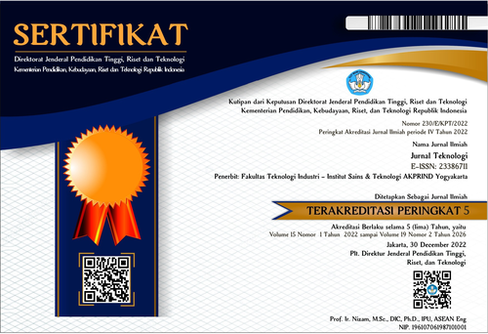Pengembangan Aplikasi Augmented Reality Pada Mata Pelajaran Bahasa Inggris Untuk Kelas 1 Sekolah Dasar
DOI:
https://doi.org/10.34151/jurtek.v16i1.4237Keywords:
Augmented Reality, Learning app, ADDIEAbstract
This research was developed to overcome problems in students who tend to get bored in English subjects with book media. This research aims to develop Augmented Reality in English subject for grade 1 elementary school. The research method used in this study namely research and development (R&D) with the ADDIE application development model (Analysis, design, development, implementation, and evaluation), in this study is limited to stage implementation. Products are developed using game engine Unity 3D and Vuforia. Data analysis techniques in this study will use descriptive and quantitative analysis techniques. The data collection instrument used was a questionnaire with 8 respondents. The end result of the product is an educational game-based application Augmented Reality learning English which contains 3D objects, descriptions, sentences and sounds from objects that are run. The results of the feasibility test obtained an average score of 81.90% in the very good category. With the application Augmented Reality this is expected to help 1st grade elementary school students in learning English.
Downloads
References
Ashidik, J. P., Waluyo, S., & Susanti, I. (2021). Penerapan Teknologi Augmented Reality Berbasis Android Dengan Menggunakan Metode Marker Based Tracking Sebagai Media Pemasaran Produk Pada Haus Coffee. Skanika, 4(1), 51–57. https://doi.org/10.36080/skanika.v4i1.1936
Brata, K. C., & Brata, A. H. (2018). Pengembangan Aplikasi Mobile Augmented Reality untuk Mendukung Pengenalan Koleksi Museum. Jurnal Teknologi Informasi Dan Ilmu Komputer, 5(3), 347. https://doi.org/10.25126/jtiik.201853798
Febrianti, F. (2019). Efektivitas Penggunaan Media Grafis Dalam Meningkatkan Motivasi Belajar Siswa. Prosiding Seminar Nasional Pendidikan FKIP, Universitas Sultan Ageng Tirtayasa, 2(1), 667–677.
Irfan Sural. (2018). Augmented Reality Experience: Initial Perceptions of Higher Education Students,. International Journal of Instruction, , 11(4), 565–576. https://eric.ed.gov/?id=EJ1191718
Latip, A., & Permanasari, A. (2016). Pengembangan Multimedia Pembelajaran Berbasis Literasi Sains Untuk Siswa Smp Pada Tema Teknologi. Edusains, 7(2). https://doi.org/10.15408/es.v7i2.1761
Mokodompit, M. F., Paturusi, S. D. E., & ... (2021). Aplikasi Augmented Reality Untuk Pembelajaran Bahasa Inggris Pada Anak Sekolah Dasar. Jurnal Teknik …, 16(2), 121–128. https://ejournal.unsrat.ac.id/index.php/informatika/article/view/33197%0Ahttps://ejournal.unsrat.ac.id/index.php/informatika/article/viewFile/33197/32388
Sirakaya, M., & Cakmak, E. K. (2018). The effect of augmented reality use on achievement, misconception and course engagement. Contemporary Educational Technology, 9(3), 297–314. https://doi.org/10.30935/cet.444119
Siti Zubaidah. (2018). Mengenal 4C: Learning and Innovation Skills Untuk Menghadapi Era Revolusi Industri 4.0. 2nd Science Education National Conference, September, 1–7.
Sugiyono, S. (2017). Metode Penelitian Kuantitatif, Kualitatif, dan R&D (26th Editi). Alfabeta.
Susanto, E. S., Hamdani, F., Nuryansah, F., & Oper, N. (2022). Pengembangan Aplikasi Smart-Book Sebagai Media Pembelajaran Bahasa Inggris Anak Berbasis Ar (Augmented Reality). Jurnal Mnemonic, 5(1), 64–71. https://doi.org/10.36040/mnemonic.v5i1.4438
Downloads
Published
How to Cite
Issue
Section
License
Copyright (c) 2023 Fendy Nanang Setiawan, Mohammad Zaenal Abidin, Dwi Ratnawati

This work is licensed under a Creative Commons Attribution 4.0 International License.
Jurnal Teknologi provides immediate open access to its content in order of making research freely available to the public to support a global exchange of knowledge. All articles published in this journal are free for everyone to read and download, under licence CC BY SA.
Benefits of open access for the author, include:
- Free access for all users worldwide.
- Authors retain copyright to their work.
- Increased visibility and readership.
- No spatial constraints.




















